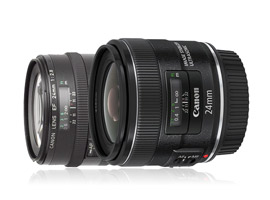Introduction
Touted by Canon as the world’s first wide-angle prime lens with IS, which delivers up to four stops of correction, the new EF 24mm f/2.8 IS USM is geared for landscape and architectural shooting, photo reportage, and travel photography. The silent high-speed AF motor makes it well-suited for shooting video as well. The lens’ redesigned optics include aspherical lens elements to correct aberration and improve peripheral image quality.
While the EF 24mm f/2.8 (now discontinued) has held its own since 1988, the improved optics and IS mean that the new lens should be able to perform better than its predecessor in low-light settings. We put the two lenses to the test side-by-side to find out what the true performance differences are.
Improved resolution and light transmission
As we’d expect given the new optics, the EF 24mm f/2.8 IS USM was able to outperform the EF 24mm f/2.8 despite its similar specifications. The Sharpness score for the new lens places it among lenses with the top score of 17 perceptual megapixels (P-MPix) when mounted on a full-frame Canon EOS 5D Mark II. The older EF 24mm f/2.8 scores acceptably at 14P-MPix, but the the newer optics make a noticable difference in resolution.
The new lens also shines when it comes to light transmission, with a Transmission Score that’s spot-on for an f/2.8 lens with a 2.8TStop. The EF 24mm f/2.8 on the other hand tested low for transmission coming in with a 3.3TStop, indicating that it loses a half stop.
Both lenses perform well on the Distortion metric, indicating that distortion is well controlled for such a short focal length. They also perform similarly on the Vignetting metric, both scoring -2EV, with lens shading strong at full aperture f/2.8 and still noticable between f/4 to f/22—not surprising for lenses at this focal length and aperture.
Slight chromatic aberration is noticable using both lenses, which scored similarly at 12µm and 13µm respectively for the new IS USM lens and the original lens.
Canon EF 24mm f/2.8 IS USM vs. Canon EF 24mm f/1.4L II USM vs. Carl Zeiss Distagon T 21mm f/2.8 ZE Canon mounted on Canon EOS 5D Mark II
The new Canon EF 24mm f/2.8 IS USM doesn’t just compare well with its predecessor, however. It also holds up against wide-angle prime lenses that sell for more than twice its $849 price tag, such as the Canon EF 24mm f/1.4L II USM ($1,749), from Canon’s high-end L series, and even the Carl Zeiss Distagon T 21mm f/2.8 ZE Canon ($1,843). We tested all three lenses mounted to a Canon EOS 5D Mark II and found that in comparison to the more expensive lenses, the EF 24mm f/2.8 IS USM achieved a similarly impressive Sharpness score of 17P-Mpix compared to the higher-end Canon EF 24mm F/1.4L II USM’s score of 16M-MPix and even better than the Carl Zeiss Distagon lens’ score of 13P-MPix.
Taking a closer look at the sharpness measurements and field maps (below), we can see that both Canon lenses perform very well and deliver similarly consistent sharpness between f/2.8 and F/22. From f/1.4 to f/2, the L series lens delivers good sharpness in the center that softens toward the edges of the frame, but at an acceptable level. The Zeiss lens doesn’t match up to either Canon lens—though resolution is sharp in the center, it decreases quickly toward the edges for all apertures.

In terms of light transmission, the Canon L series lens is obviously a brighter lens and therefore delivers a better score at 1.6TStop. But although the new Canon lens and the Zeiss lens have the same theoretical aperture of f/2.8, the Canon is 1/2EV brighter than the more-expensive Zeiss lens: the Canon measured accurately at 2.8 whereas the Zeiss tested low, losing a half stop and coming in with a 3.3TStop.
Where the Zeiss lens stands out among the three is in the chromatic aberration test, on which it scored a 5µm compared to 12µm and 9µm for the Canon f/2.8 lens and L series f/1.4 lenses, respectively. The Zeiss performed well for all apertures in chromatic aberration, whereas for both Canons, chromatic aberration should be slightly noticable.
Ultimately, the test results indicate that the Canon EF 24mm f/2.8 IS USM delivers better image quality for the money. While the Canon EF 24mm f/1.4L II USM offers similarly good resolution and is brighter and has better control of lens shading, at twice the price of the f/2.8, it’s not as good a value. And the even more pricey Carl Zeiss Distagon T 21mm f/2.8 ZE is frankly a bit disappointing when compared to both Canon lenses: While it performs better than both in chromatic aberration control, its resolution is significantly lower than both at f/2.8 and above, and transmission is a bit low as well.
Almost a quarter century after the release of its predecessor, Canon’s new 24mm f/2.8 prime lens is shaping up to be a worthy successor. Not only does the Canon EF 24mm f/2.8 IS USM add optical image stabilization (for up to four stops of correction) and a new ultrasonic autofocus motor, but after putting the lens through the paces of DxOMark testing, it has proved to be a top-notch performer as well, delivering excellent value for its $849 price. Not only does it outperform its predecessor in Sharpness and Transmission scores, but it also stands up to lenses that sell for more than twice the price, outperforming the Carl Zeiss Distagon T 21mm f/2.8 ZE on multiple tests and matching or besting the high-end Canon EF 24mm f/1.4L II USM on DxOMark tests.





DXOMARK encourages its readers to share comments on the articles. To read or post comments, Disqus cookies are required. Change your Cookies Preferences and read more about our Comment Policy.